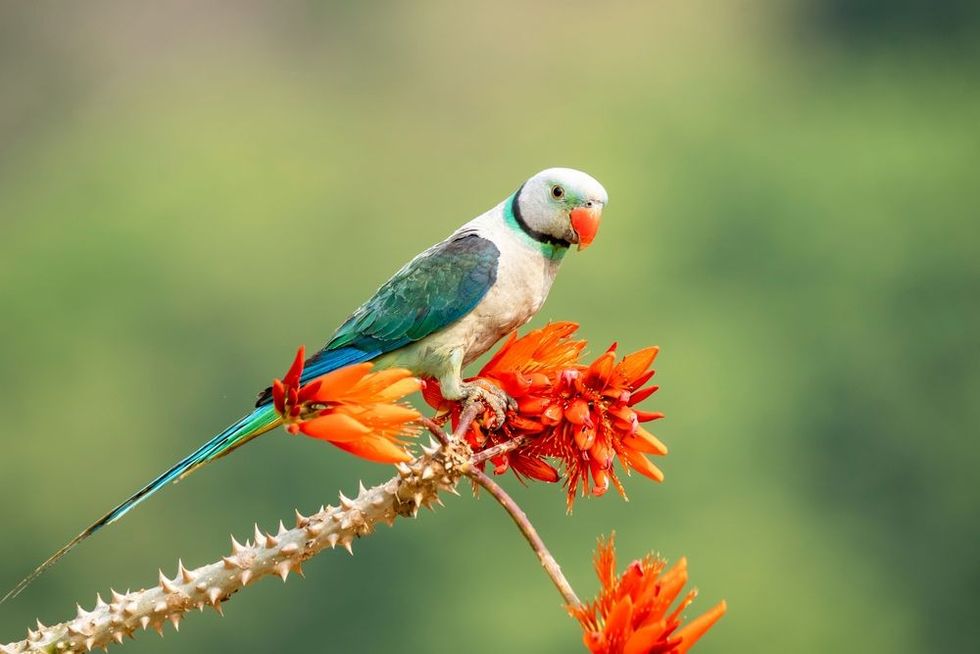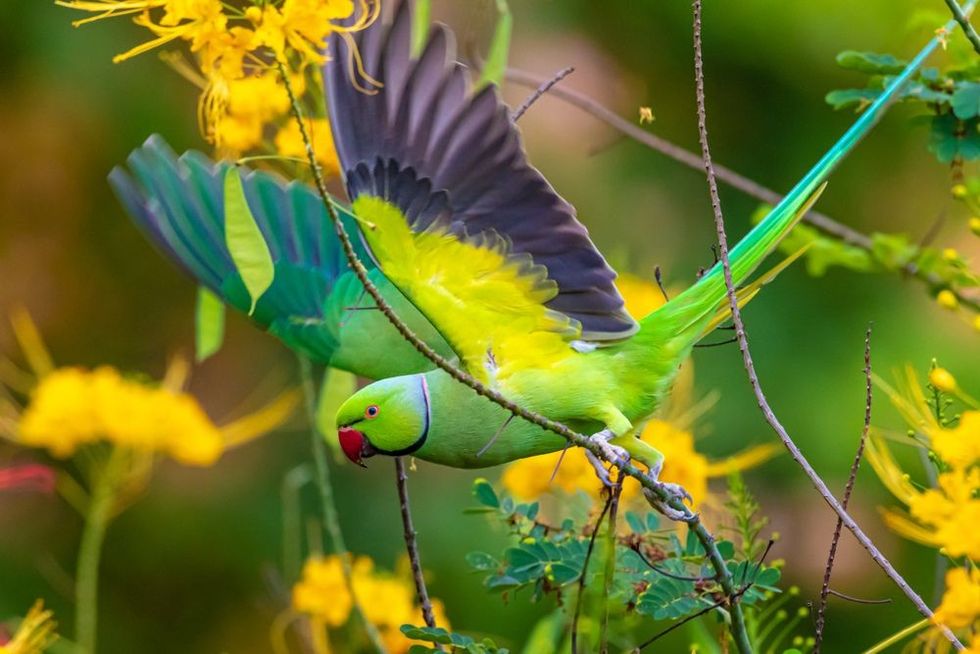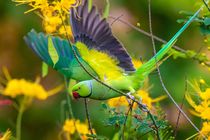Fancy Parakeet: What Do They Look Like And Should You Get One?

The budgerigar or budgie is a small member of the parrot family that is known as a parakeet in the US.
The name "parakeet" is derived from the French word "perroquet" that translates to "parrot". The English budgie or the American parakeet has made its way across the world as a popular pet bird.
The fancy parakeet group consists of several varieties of budgies that are known for their brightly colored feathers and their small size, along with their ability to thrive in captivity provided they are taken care of properly.
This bird is extremely affectionate towards its owner and can learn several tricks if taught properly.
The American English term "parakeet" is mostly reserved for the budgie class because of which confusion can occur between true parakeets and budgies. In most cases, the term budgie is just used as a replacement for parakeet and the two are the same bird.
However, the fact that not all parakeets are budgies and not all budgies are parakeets is a known fact, and hopefully, by the end of this article, you will be able to differentiate between them!
If you like this article about fancy parakeets, be sure to check out articles about can parakeets talk and can parakeets eat bananas!
What is the difference between an English budgie and a parakeet?
The parakeet and the English budgie can be distinguished from each other because of their appearance and temperament. The American budgie or parakeet is smaller in size and is louder than the English budgie.
The English budgie is larger in comparison to the parakeet and has a nonchalant nature and is suited more to domestication.
Rarest Parakeet Color
The parakeet species belong to the parrot family and are known for being social birds that can become great pets if they are cared for properly.
Parakeets are colorful birds and have a great demand as pet birds. Due to this high demand, pet parakeets are often bred with each other to produce various parakeet colors.
The rarest parakeet color is of the Anthracite parakeets, which have a dark charcoal gray color, and this little bird can be the rarest pet parakeet if you can get your hands on it.
Other less rare parakeets are the rainbow, lacewing, and clearwing parakeets. These rare colored feathers are the product of genetic mutations. These rare colored feathers on a parakeet can be common over time. One such case is that of the rainbow parakeet, which has become much more common nowadays.
Mixed breed parakeets have seen a wide increase in demand as pet birds because of which they go through selective breeding. In the case of captive parakeets, this little bird class is divided into two categories which include yellow-based and white-based colors.
Yellow-based parakeets have a color variation of light and dark green, green is seen as the original color of this bird, and parakeets with green feathers are most commonly found in the wild.
The green color helps these parakeets to blend in with their surroundings to escape predators like larger birds which includes the macaws. Common markings that can be found in the green parakeets are yellow heads, yellow stripes, blue cheeks, and blue tail feathers.
Green parakeets can also be olive green or light green.
Green parakeets are common because of their dominant genes. Alongside green, blue is also a common color, but it can be difficult to produce as blue genes are recessive.
White-based parakeets come in colors like white, violet, gray, and blue.
What is a fancy parakeet?
Fancy parakeets are intelligent birds that are known for their long tail and colorful feathers and can be great pet birds. These beautiful birds are also known as budgie or budgerigar in Australia.
These birds are small and social and can pick up on commands and actions due to their intelligence. They have a diet that consists of plants, vegetables, seeds, and fruits, and their lifespan is estimated to be around 5-8 years if their health is maintained.
These beautiful birds are one of the most vocal birds in the parrot family which gives them the title of fascinating birds that can be kept as pets. Happy parakeets often show their amazement and happiness by tweeting, talking, chirping, and mimicking sounds that they hear.
However, unlike other members of the family of parrots, like macaws, the budgerigar does not speak as clearly.
Lifespan Of A Fancy Parakeet
The average lifespan of a healthy and happy parakeet is estimated to be between 7-10 years.
In the wild, despite being a member of the bird family, these little birds are often targeted by larger birds as prey. Larger bird varieties often prey on other birds and the parakeet is not excluded from this.
In tropical surroundings, especially during the nesting season, large birds like eagles and hawks often target the young ones as well the adult budgie. These birds are also known to prey on larger parrots too.
The average lifespan of your budgie can be extended through proper care which includes taking care of them in all sorts of manners like maintaining a proper diet and providing them with ample food supplies, which in some cases should be hand-fed.
Sometimes pet birds can often become depressed, especially if they are alone, and this might lead to premature death. To avoid this, you will need to spend time with them doing various things together.
To extend the lifespan of your pet parakeet, you will need to clean the cage regularly, encourage them when they are being playful, handle them with care as they can be fragile, especially babies. You will also need to keep talking to your pet parakeet as well as earn their trust by letting them fly around.
The most important thing that needs to be done to keep a check on your budgie is to keep an eye out for any sort of developing health issue.
As pet parents, it is up to you to provide the best condition for your budgie to thrive. This breed of bird needs a lot of space and has to be fed different fresh food items. Fresh water should always be provided to them.
To earn the trust of your budgie you will need to spend a lot of time with them and take part in various trust-building exercises.
Since your budgie is a curious bird, toys should be provided so that it can learn to climb, explore and chew. New toys should be introduced slowly to avoid any sort of unsettling affair. If your parakeet likes to be out of the cage, a playpen should be created to let it explore and learn activities.
Paper toys are a great example of low-key toys that can be used to amuse your budgie, roll the paper and push it towards your budgie, if it chews and tears the paper, roll another one and put it in the cage to keep them amused.
Talking and singing is another method of keeping your parakeet active as they will listen to it and try to imitate the things that they catch on to.
Since the parakeet is different from parrots, their speech is not as clear as parrots, so you will need to listen carefully for words and phrases that your parakeet might form while talking.
Teaching your parakeet tricks is yet another way to keep them active by keeping their brain functioning. You can teach your parakeet to perch on your fingers by putting your hand inside the cage and pushing the abdomen with your fingers to get them to perch on it.
At first, your budgie might hesitate but with enough repetitions, it will eventually learn to perch on it.
You can also let your pet parakeet out of the cage, but make sure you prepare before doing so and create a bird-proof surrounding for the best outcome.

Parakeets vs Budgies
Budgies and parakeets are typically the same animals, however, a budgie is a species of parakeet. The mixup between budgies and parakeets is because of the name, as in the US, budgies are known as parakeets, whereas, they are known as budgies in the rest of the world.
So, to make it even simpler, all budgies are parakeets, but not all parakeets are budgies. The parakeet family consists of many different species. Both birds have similar characters and personalities, however, the difference is only seen in color and size. Both birds are intelligent, affectionate, and social birds and will make excellent pets.
An in-depth analysis of these two different bird classes can help in being more aware of their basic needs, and health concerns.
The budgie is seen as a beginner bird as it is relatively smaller than parakeets and has low maintenance needs.
These birds are intelligent which makes it easier to keep them compared to other classes of parrots. Budgies live in small flocks in their natural habitat, and hence, should always be kept in pairs in captivity as pets and they are relatively cheap, as a pair will cost you around $40 to $70 USD.
For budgies, aviaries are ideal, but large cages can also do the work if they are fitted with accessories necessary for activities.
Budgies are lively, curious, and playful birds and make delightful companions. Their small size does not hold them back in any way as they are full of energy and love to have fun.
For a kid, a budgie will be a great pet as these birds are great with children and are quieter than other parrot species. These birds are interested in their surroundings and love to learn and explore.
Budgies are intelligent in nature and can be easier to train and will show signs of affection if handled from a young age. As a result of this, budgies do not need human interaction all the time as they are kept in pairs and can find ways to entertain themselves.
These birds can be kept as an observing-only pet too. If you are training your budgie to speak, it is more likely that the male will learn faster as males are known for their ability to mimic speech.
Even though budgies are small and easy to care for pets, they need as much attention and love as any other pet.
To keep them healthy, you will need to maintain a healthy diet and eating habits and provide them with lots of mental and physical stimulation with a cage large enough to fly around that comes with playthings to keep them occupied.
Parakeets are bird classes that are small-medium-sized and have long tails that help distinguish them from other pet bird breeds. Parakeets are found in their natural wild habitat all across the world, but their highest population density is in Australia, where they can be found in over 30 different varieties.
All the parakeet varieties have a tapered tail, with diverse and bright coloring, and the bird's beak is multi-faceted.
The parakeet family is larger than the budgie but they are brimming with personality and are charismatic and stylish like other larger parrots. A pet parakeet is easy to take care of because it can easily adapt to life in captivity, provided it has a large cage, and that they are tamed from an early age.
Pet parakeets are extremely social and love to bond with their owners as they appreciate human interaction.
These intelligent birds are also easy to tame but are notoriously talkative and can mimic speech with ease. Some parakeets can even learn over 1,500 words.
These birds are tame and will start interacting with humans within two weeks. They are fast learners which means they can learn words and tricks easily. It is recommended to teach tricks to your parakeet individually for a better outcome.
These small birds are easier to take care of in comparison to larger species of parrots, however, they need more or less the same amount of attention, a healthy diet, nutritious food, and treats to live a fulfilling life.
Ethics Of Fancy Parakeets
The ethics behind keeping a fancy parakeet is often shrouded with uncertain answers as each individual will have a different answer to the question.
Questions like - Should people keep birds as pets? Is it right to keep a bird as a pet? - can be answered in various ways.
For example, a bird that has seen most of its life in captivity will not be able to survive in the wild. If a person is fully prepared to keep birds like a parrot or a budgie as a pet, they should be able to provide the best care for them according to their own beliefs.
However, if that person is irresponsible, then they should know better than to take in any sort of pet as their attitude towards the pet can lead to its premature death.
So, the ethics are not clear and it fully depends on how people treat their pet bird, or any other pet that they are taking care of.
Here at Kidadl, we have carefully created lots of interesting family-friendly facts for everyone to enjoy! If you liked our suggestions for fancy parakeet then why not take a look at how long do parakeets live, or slaty headed parakeet facts!
We Want Your Photos!
More for You
See All
Bachelor of Arts specializing in English, Master of Arts specializing in English

Rajnandini RoychoudhuryBachelor of Arts specializing in English, Master of Arts specializing in English
With a Master of Arts in English, Rajnandini has pursued her passion for the arts and has become an experienced content writer. She has worked with companies such as Writer's Zone and has had her writing skills recognized by publications such as The Telegraph. Rajnandini is also trilingual and enjoys various hobbies such as music, movies, travel, philanthropy, writing her blog, and reading classic British literature.
Bachelor of Science specializing in Microbiology, Masters of Science specializing in Biotechnology

Pratiti NathBachelor of Science specializing in Microbiology, Masters of Science specializing in Biotechnology
A Master's in Biotechnology from Presidency University and a Bachelor's in Microbiology from Calcutta University. Pratiti holds expertise in writing science and healthcare articles, and their inputs and feedback help writers create insightful content. They have interests in heritage, history, and climate change issues and have written articles for various websites across multiple subjects. Their experience also includes working with eco-friendly startups and climate-related NGOs.
Disclaimer
1) Kidadl is independent and to make our service free to you the reader we are supported by advertising. We hope you love our recommendations for products and services! What we suggest is selected independently by the Kidadl team. If you purchase using the Buy Now button we may earn a small commission. This does not influence our choices. Prices are correct and items are available at the time the article was published but we cannot guarantee that on the time of reading. Please note that Kidadl is a participant in the Amazon Services LLC Associates Program, an affiliate advertising program designed to provide a means for sites to earn advertising fees by advertising and linking to Amazon. We also link to other websites, but are not responsible for their content.
2) At Kidadl, we strive to recommend the very best activities and events. We will always aim to give you accurate information at the date of publication - however, information does change, so it’s important you do your own research, double-check and make the decision that is right for your family. We recognise that not all activities and ideas are appropriate for all children and families or in all circumstances. Our recommended activities are based on age but these are a guide. We recommend that these ideas are used as inspiration, that ideas are undertaken with appropriate adult supervision, and that each adult uses their own discretion and knowledge of their children to consider the safety and suitability. Kidadl cannot accept liability for the execution of these ideas, and parental supervision is advised at all times, as safety is paramount. Anyone using the information provided by Kidadl does so at their own risk and we can not accept liability if things go wrong.
3) Because we are an educational resource, we have quotes and facts about a range of historical and modern figures. We do not endorse the actions of or rhetoric of all the people included in these collections, but we think they are important for growing minds to learn about under the guidance of parents or guardians.







